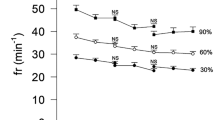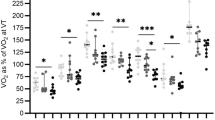Summary
The aim of this study was to investigate the effect of growth on ventilation and breathing pattern during maximal exercise oxygen consumption (VO2max and their relationships with anthropometric characteristics. Seventy six untrained schoolboys, aged 10.5–15.5 years, participated in this study. Anthropometric measurements made included body mass, height, armspan, lean body mass, and body surface area. During an incremental exercise test, maximal ventilation (VEmax), tidal volume (V Tmax), breathing frequency (f max), inspiratory and expiratory times (t Imax and t Emax), total duration of respiratory cycle (t TOTmax), mean inspiratory flow (V T/t Imax), and inspiration fraction (t I/t TOTmax) were measured at VO2max. A power function was calculated between anthropometric characteristics and ventilatory variables to determine the allometric constants. The results showed firstly, that VEmax, V Tmax, t Imax, t Emax, t TOTmax, and V T/t Imax increased with age and anthropometric characteristics (P<0.001), f max decreased (P<0.001), and t I/t TOTmax remained constant during growth; secondly that lean body mass explained the greatest percentage of variance of VEmax (62.1%), V Tmax (76.8%), and V T/t Imax (70.6%), while anthropometric characteristics explained a slight percentage of variance of f max and timing; and thirdly that VEmax, V Tmax, and V T/t Imax normalized by lean body mass did not change significantly with age. We concluded that at VO2max there were marked changes in ventilation and breathing pattern with growth. The changes in VEmax, V Tmax, and V T/t Imax were strongly related to the changes in lean body mass.
Similar content being viewed by others
References
Asmussen E, Secher NH, Andersen EA (1981) Heart rate and ventilatory frequency as dimension dependent variables. Eur J Appl Physiol 46:379–386
Åstrand PO (1952) Experimental studies of physical working capacity in relation to sex and age. Ejnar Munksgaard, Copenhagen
Boggs DF, Tenney SM (1984) Scaling respiratory pattern and respiratory drive. Respir Physiol 58:245–251
Boule M, Gaultier C, GirardF (1989) Breathing pattern during exercise in untrained children. Respir Physiol 75:225–234
Cook CD, Mead J, Orzalesi MM (1964) Static volume-pressure characteristics of the respiratory system during maximal efforts. J Appl Physiol 19:1016–1022
Davies CTM, Barnes C, Godfrey S (1972) Body composition and maximal exercise performance in children. Hum Biol 44:195–241
Durnin J, Rahaman N (1967) The assessment of the amount of fat in the human body from measurements of skinfold thickness. Br J Nutr 21:681–689
Gadhoke S, Jones NJ (1969) The responses to exercise in boys aged 9–15 years. Clin Sci 37:789–801
Gallagher CG, Brown E, Younes M (1987) Breathing pattern during maximal exercise and during submaximal exercise with hypercapnia. J Appl Physiol 63:238–244
Gaultier C, Girard F (1980) Croissance pulmonaire normale et pathologie: relations structure fonction. Bull Eur Physiopathol Respir 16:791–842
Gaultier C, Perret L, Boule M, Buvry A, Girard F (1981) Occlusion pressure and breathing pattern in healthy children. Respir Physiol 46:71–80
Gould SJ (1966) Allometry and size in ontogeny and phylogeny. Biol Rev 41:587–640
Guyton AC (1947) Analysis of respiratory pattern in laboratory animals. Am J Physiol 150:78–83
Heusner A (1983) Mathematical expression of the effects of changes in body size on pulmonary function and stature. Am Rev Respir Dis 128:572–574
Jammes Y, Auran Y, Gouvernet J, Delpierre S, Grimaud C (1979) The ventilatory pattern of conscious man according to age and morphology. Bull Eur Physiopathol Respir 15:527–540
Jones NL, Makrides L, Hitchcock C, Chypchar T, McCartney N (1985) Normal standards for an incremental progressive cycle ergometer test. Am Rev Respir Dis 131:700–708
Lange Andersen K, Rutenfranz J, Seliger V, Ilmarinen J, Berndt I, Kylian H, Ruppel M (1984) The growth of lung volumes affected by physical performance capacity in boys and girls during childhood and adolescence. Eur J Appl Physiol 52:380–384
Lebowitz MD, Holberg CJ, Knudson RJ, Burrows B (1987) Longitudinal study of pulmonary function development in childhood, adolescence, and early adulthood. Am Rev Respir Dis 136:69–76
Milic-Emili J, Grunstein MM (1976) Drive and timing components of ventilation. Chest [Suppl] 70:131–133
Milic-Emili J, Whitelaw WA, Derenne JP (1975) Occlusion pressure a simple measure of the respiratory center's output. N Engl J Med 293:1029–1030
Ramonatxo M, Mercier J, El-Fassi-Ben Abdallah R, Bauer C, Prefaut C (1986) Breathing pattern and occlusion pressure during exercise in pre- and peripubertal swimmers. Respir Physiol 65:351–364
Ramonatxo M, Mercier J, Préfaut C (1989) Relationship between aerobic physical fitness and ventilatory control during exercise in young swimmers. Respir Physiol 78:345–356
Rutenfranz J, Lange Andersen K, Seliger V, Klimmer F, Berndt I, Ruppel M (1981a) Maximum aerobic power and body composition during the puberty growth period: similarities and differences between children of two European countries. Eur J Pediatr 136:123–133
Rutenfranz J, Lange Andersen K, Seliger V, Klimmer F, Ilmarinen J, Ruppel M, Kylian H (1981b) Exercise ventilation during the growth spurt period: comparison between two European countries. Eur J Pediatr 136:135–142
Tenney SM, Barlett D (1967) Comparative quantitative morphology of the mammalian lung trachea. Respir Physiol 3:13–135
Weiner JS, Lourie JA (1981) Practical human biology. Academic Press, London, pp 27–52
Yernault JC, Baran D, Englert M (1977) Effect of growth and aging in the static mechanical lung properties. Bull Eur Physiopathol Respir 13:777–788
Author information
Authors and Affiliations
Rights and permissions
About this article
Cite this article
Mercier, J., Varray, A., Ramonatxo, M. et al. Influence of anthropometric characteristics on changes in maximal exercise ventilation and breathing pattern during growth in boys. Eur J Appl Physiol 63, 235–241 (1991). https://doi.org/10.1007/BF00233854
Accepted:
Issue Date:
DOI: https://doi.org/10.1007/BF00233854




